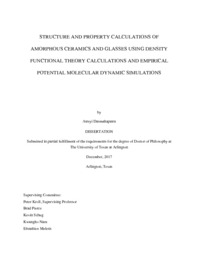
ATTENTION: The works hosted here are being migrated to a new repository that will consolidate resources, improve discoverability, and better show UTA's research impact on the global community. We will update authors as the migration progresses. Please see MavMatrix for more information.
Show simple item record
| dc.contributor.advisor | Kroll, Peter | |
| dc.creator | Dasmahapatra, Atreyi | |
| dc.date.accessioned | 2023-09-11T15:18:18Z | |
| dc.date.available | 2023-09-11T15:18:18Z | |
| dc.date.created | 2017-12 | |
| dc.date.submitted | December 2017 | |
| dc.identifier.uri | http://hdl.handle.net/10106/31695 | |
| dc.description.abstract | The work in this thesis involves modeling amorphous ceramics and glasses using the tools of DFT and classical MD. Systems investigated include: metal-silicate glasses (in particular HfO2- SiO2), composite coatings (comprising of Zr-Si-B-C-N), and the refractory materials amorphous silicon nitride (a-Si3N4) and amorphous silicon boron nitride (a-SiBN). Modeling techniques include traditional “melt-and-quench” simulations combined with simulated annealing. Structures are further investigated for their physical and chemical properties. A brief overview of each chapter is given below:
Hafnia-silica glasses (HfO2-SiO2) find applications in microelectronics and optical waveguides. I did a computational study of the thermochemistry of these compounds exploring enthalpy of mixing and solubility. Additional analysis of vibrational modes in mixed glasses highlighted that adding a heavy Hafnium (Hf) atom will reduce thermal conductivity in these glasses.
Zirconium borides, carbides, and nitrides are Ultra High Temperature Ceramics (UTHCs) and candidates for thermal protective coatings in hypersonic vehicles. At elevated temperatures these materials have poor oxidation resistance. Adding silicon nitride promoted formation of a protective silica glass layer upon oxidation. With this goal in mind, I modeled Zr-Si-B-C-N ceramics, mixtures of ZrB2, ZrN, ZrC and Si3N4 with different composition and analyzed the impact of Si3N4 on their mechanical properties. This project is a part of the “Materials Genome Initiative” which aims to accelerate advanced materials discovery.
Amorphous silicon nitride (Si3N4) and silicon boron nitride (SiBN) ceramics exhibit outstanding thermal and mechanical properties and are used as high-temperature protective coatings in extreme environments. I provided a comparative study of empirical potentials for modeling Si3N4 and outlined quality – and failure – of seven different approaches. My study also highlights the capabilities of one “forgotten” potential, which should receive more credit in research. For a-SiBN, I study the impact of composition, density and temperature on the thermal conductivity of the material. The dispersion of segregated boron nitride (BN) domains inside a-SiBN structure impact the thermal transport in these materials. | |
| dc.format.mimetype | application/pdf | |
| dc.language.iso | en_US | |
| dc.subject | Computational | |
| dc.subject | DFT | |
| dc.subject | Molecular Dynamics | |
| dc.subject | atomistic simulations | |
| dc.subject | thermal conductivity | |
| dc.title | STRUCTURE AND PROPERTY CALCULATIONS OF AMORPHOUS CERAMICS AND GLASSES USING DENSITY FUNCTIONAL THEORY CALCULATIONS AND EMPIRICAL POTENTIAL MOLECULAR DYNAMIC SIMULATIONS | |
| dc.type | Thesis | |
| dc.date.updated | 2023-09-11T15:18:18Z | |
| thesis.degree.department | Chemistry and Biochemistry | |
| thesis.degree.grantor | The University of Texas at Arlington | |
| thesis.degree.level | Doctoral | |
| thesis.degree.name | Doctor of Philosophy in Chemistry | |
| dc.type.material | text | |
Files in this item
- Name:
- DASMAHAPATRA-DISSERTATION-2017.pdf
- Size:
- 17.14Mb
- Format:
- PDF
This item appears in the following Collection(s)
Show simple item record


